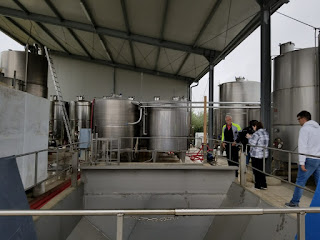During the colder months of less and less sunshine, it seem that winter pulls us downward. The earth dies back aand the seeds hide underground, while they must wait for spring and rebirth. Some say this is a time when the dead feel
an attraction to the living and hope to return for a visit, as they are
said to do in Orsara di Puglia. Families set the table for ancestors returning from their graves.
Long before a calendar told us when the new year would begin, many would celebrate this time as the new year. This is the end of the harvest when people would gather and prepare for the long winter. "The wheat has been sown
and the fruit all crated." It wasn't until the 9th century that the
Church in Italy drew a veil of religion over the festival, and renamed it Ognissanti, All Saints Day. The festival of death as birth
into the church and eternity, commemorates the death of saints and souls by
celebrating traditions in Italy on November 1st and 2nd. These nights provided the opportunity to honor,
reconnect and pay respect to the spirits of loved ones.
It
is said that the night is a magical, spiritual experience for everyone
to experience. The Orsaresi who live in other parts of
Italy and Europe come home for the festa, and visitors come from all
over Puglia. Since it is a holiday, many families are able to take an
extra long weekend known as il Ponte dei Morti.
Many
believe that the night between November 1 and 2, the souls of the
recently departed return among the living to visit their relatives and
their former homes before moving onto Paradise. The entire city of
Orsara is lit with Bonfires of wood and branches of (ginestra) or
broom. The light of the fires, the crackling and sparks from the
brooms reach out for the sky attracting the spirits so they may reunite with the living.
The pumpkin lanterns are carved to look like heads or carved with crosses to
light their way so the spirits can find their former home. The preparation involves
gathering of firewood, preparing food for family and friends and picking hundreds of locally grown pumpkin or zucca which are carved
and placed all over Orsara. This is the busiest night of the year for restaurants and bars. The town hosts a pumpkin carving workshop and there is even a contest for the best decorated pumpkin.
Now
when the campanile, the church bell tower, strikes 1900 hours, Orsara di
Puglia "catches fire." Bonfires are simultaneously lit in every street and piazza. where they remain lit through the night. The fires, illuminated pumpkins, music and people in the streets create a magical enchanted atmosphere. There are three large squares in the city and every quarter neighborhood, and many families also light their own.
Now
the food in honor of the dead, is simple but symbolic, seasonal foods. They are
cooked on the open fires and also served as we would call street food. Potatoes, onions and sausages, roasted chestnuts and pane
cotto-bread cooked with garlic, potatoes and greens are some of the favorites.

The
one I remember my grandmother Maria Antoinette Dedda-Fragassi always making was Muscitaglia a traditional dish she served on November 1st.
This dates back to the ancient Greeks and Byzantines. The ingredients are symbolic of fertility and abundance, but also of honor and respect for the dead.
Muscitaglia is made up of the Greek and Latin words
mosto (wine must) and
talia (grain).
While
in Orsara, a few weeks ago, we were serve Muscitaglia for dessert and it
reminded me of Grandma the only difference is that she made hers for
breakfast and ate it with milk and honey. So that brings me to MOSTO
COTTO- A thick, molasses like syrup made by boiling down fresh grape
must. Mosto cotto is served as a kind of poor man's honey. Now when my grandma was here in American she couldn't find mosto cotto, so that explains
the honey and the milk. Or maybe she felt America
was the land of milk and honey for her.

























































